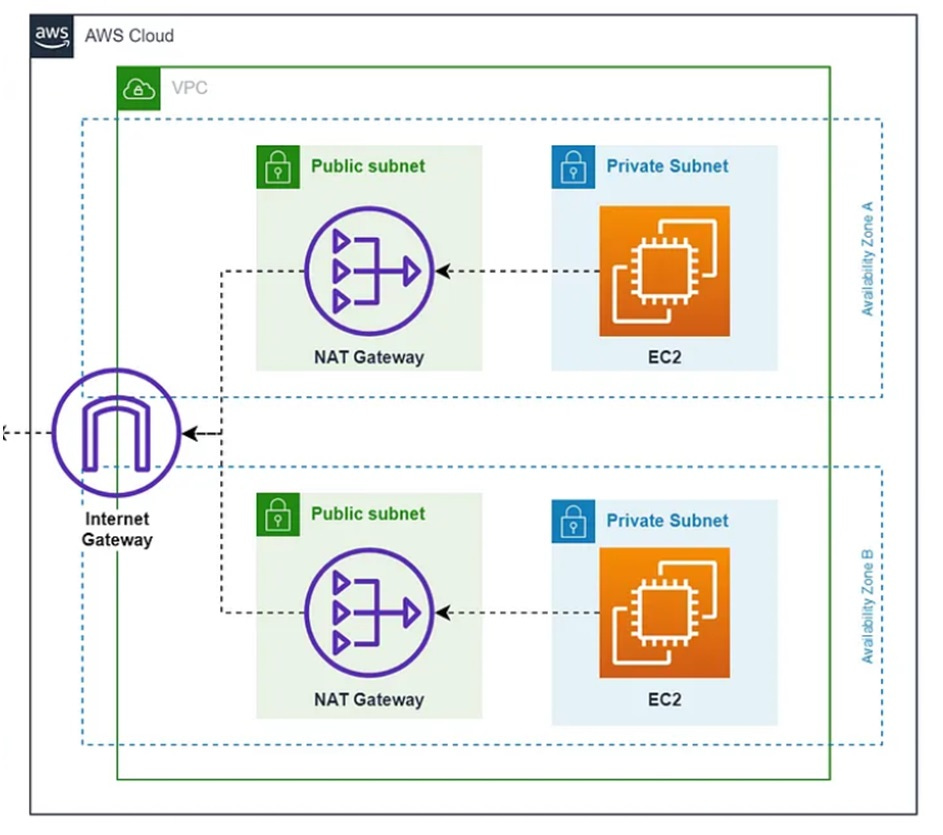IGW or NAT Gateway ?
When you have to think of how to manage outbound internet traffic in a cloud architecture – IGW and NAT Gateway comes into picture. Two common solutions for this are Internet Gateway (IGW) and Network Address Translation (NAT) Gateway. In this blog, we'll explore these two AWS services.
Internet Gateway (IGW):
Internet Gateway (IGW) stands as a pivotal component in the VPC architecture, offering horizontally scaled redundancy and high availability. Its primary function is to facilitate bidirectional communication between your Virtual Private Cloud (VPC) and the internet. An Internet Gateway is necessary when your resources in the cloud, such as instances in a Virtual Private Cloud (VPC), need direct access to the internet. If your application involves users accessing the internet or downloading/uploading data, an IGW is typically required.
Technical Nuances:
IPv4 and IPv6 Support: IGW seamlessly supports both IPv4 and IPv6 traffic, ensuring compatibility with diverse networking requirements.
No Availability Zone Constraints: Unlike some VPC components, IGW is not tied to a specific Availability Zone, mitigating availability risks and obviating bandwidth constraints on network traffic.
Cost Implications: It's noteworthy that there is no additional charge for having an IGW in your account, making it a cost-effective solution for enabling internet access.
Benefits:
Direct Internet Access: IGW allows resources within your VPC to connect directly to the internet, making it suitable for scenarios where public access is necessary.
Simplified Configuration: Setting up an IGW is straightforward, making it a hassle-free option for providing internet access to your resources.
Web Application Hosting: If you're hosting a website or web application that needs public accessibility, an IGW is often the preferred choice.
Implementation Insight: To make a subnet public, the key step is to add a route to the subnet's route table, directing internet-bound traffic to the associated Internet Gateway. Each VPC can have precisely one IGW, underscoring its uniqueness in the VPC ecosystem.
NAT Gateway:
Network Address Translation (NAT) Gateway (NGW) is a managed service that operates unidirectionally, allowing instances in private subnets to initiate outbound connections to external services while preventing inbound connections from external entities. NAT Gateway is essential when your resources need outbound internet access but don't require direct inbound traffic from the internet. It's commonly used to allow instances in a private subnet to access software updates, external APIs, or perform other internet-dependent tasks.
Technical Aspects:
Protocol Support: NAT Gateway supports key protocols, including TCP, UDP, and ICMP, facilitating a wide array of use cases.
Elastic IP Address Association: Each public NAT Gateway can be associated with exactly one Elastic IP address, contributing to a seamless and controlled networking environment.
Billing Structure: Users are charged for the availability and data processing of NAT Gateway, making it imperative to optimize its usage based on actual needs.
Benefits:
Enhanced Security: NAT Gateway acts as a barrier between your private instances and the internet, providing an extra layer of security by not allowing direct inbound traffic.
Cost-Effective: NAT Gateway is often more cost-effective for scenarios where you don't need every instance to have its public IP address.
Outbound Traffic Control: It provides control over outbound traffic, allowing you to manage and monitor internet access from your private instances.
Transformation of Source IP Address: One distinctive feature of NAT Gateway is its ability to replace the source IP address of instances with its own IP address. This ensures a level of anonymity and security for internal resources accessing external services.
When to Use: Opt for NAT Gateway when you need a more secure and cost-effective solution for outbound internet access, especially in scenarios where direct inbound access to your instances from the internet is not required.
Conclusion: In summary, choosing between IGW and NAT Gateway depends on the specific requirements of your architecture. If direct internet access is essential, go for an Internet Gateway. If enhanced security and cost-effectiveness for outbound traffic are priorities, then a NAT Gateway might be the better choice. Understanding the needs of your application and carefully evaluating these considerations will lead to a well-informed decision in designing a robust and efficient cloud architecture.


